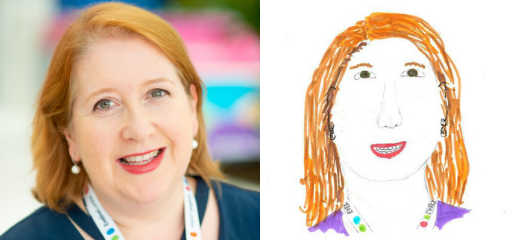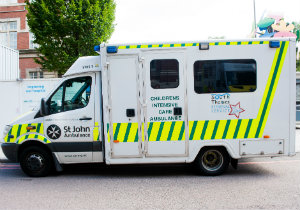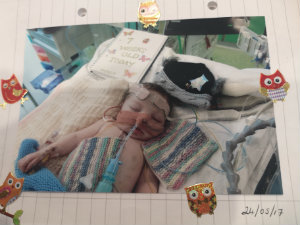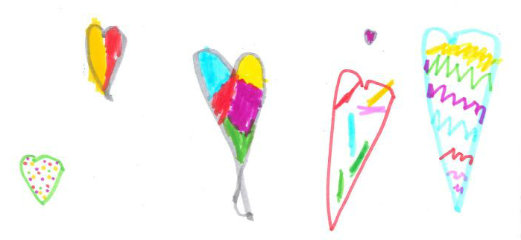
Kirsteen McCulloch, Head of Nursing for PICU and Surgery, tells us what has changed during her career.
I first joined Evelina London in 1991 to undertake my paediatric nurse training. At this time, Evelina's hospital services were still based over at Guy's Hospital rather than in their current location. After my training, I qualified as a RSCN - a Registered Sick Children’s Nurse. I still have the badge.
I joined Evelina London's PICU in 1996, starting as a senior staff nurse and working my way up. I have been Head of Nursing for surgery, theatres and Paediatric Intensive Care (PICU) since 2016.
I come from a medical family. My mum was a nurse and witnessed Christiaan Barnard's first open heart operation (heart valve surgery) in Cape Town in 1958. She watched the operation from the viewing gallery above, the bypass machine was huge! Nowadays they are much smaller.
Once qualified, I worked on Rothschild ward at Guy’s Hospital. The ward specialities were cardiology and plastic surgery. I remember one very large sink which doubled up as a baby bath, interesting times! There was a lovely old rocking horse, which always sticks in my memory. It’s on Savannah ward now and something of an antique. One of my nieces enjoyed rocking on this horse when she was a patient on Rothschild in 2001 for a heart operation which Professor Shak Qureshi performed. She came back for work experience in 2018 and was reunited with it! She also, very sweetly, used to say goodnight to the London Eye from a ward window every night.
I recall Professor David Anderson had recently been appointed as a new consultant working alongside Mr Philip Deverell when I worked on Rothschild ward. He was appointed specifically to do the ‘arterial switch operation’, a new pioneering operation for babies whose arteries (vessels taking blood from the heart to the body or lungs) are the wrong way round which causes low oxygen levels in the blood, making the baby look blue. The logical operation is to disconnect the arteries and connect them the right way round (hence the “switch”). It had been attempted many years before but technology did not support it. Before this, babies with this condition required a different operation, but this left the pumping chambers doing a job they were not designed for and the long-term outlook was poor. So far the “switch” has been successful and the oldest case is now 28 years old. The operation is now routine.
The early 90s was when we began to develop the role of intensive care specialist doctors. Prior to that, children would be managed and treated by their specialist doctors, so cardiologists (heart specialists) and nephrologists (kidney specialists) would visit the unit to manage their respective patients. It was recognised that there was a need for staff to be trained with specific intensive care skills to meet the needs of this developing speciality.
After working for a few years in other hospitals, I came back in 1996 to work in intensive care. I remember that the ward for children post cardiac surgery was a four-bedded bay with sliding door on the adult intensive care unit. There was no daylight but we at least had air conditioning! At that point, the children’s ‘hospital’ consisted of five floors of wards in Guy’s Tower.
Two vaccinations launched in the 1990s completely changed the patients we saw and how we dealt with them in paediatric intensive care. Meningococcal septicaemia, an overwhelming blood infection (often wrongly referred to as meningitis), was a very severe condition. We saw about 50 cases per year, mainly over the winter months. Thankfully, this is rarely seen now due to the ‘Meningitis B’ and ‘Meningitis C’ vaccinations. Epiglottitis, an inflammation of the airways, was also seen in those days. If it was not effectively treated, it could be fatal. The Hib vaccine was developed, which has prevented this disease. I don’t recall when I last saw a case.
Part of the evolution of PICU included the development of the retrieval service. This is where a team (doctor and nurse) would go to a district general hospital to stabilise a child needing intensive care and then bring them back to Evelina London. Initially the team went out in a taxi and would bring the child back in a normal ‘999’ ambulance. We then went out in a ‘Rapid Response Unit’ (blue light fast car) and came back in an ambulance. The timings were crucial.
 A big positive leap forward was when the South Thames Retrieval Service (STRS) was developed in 1997 following the Framework for the Future publication by the Department of Health. Our own bespoke specialised ambulances were introduced, where intensive care can be delivered during the journey back to the hospital. We became the Lead Centre in South East England and would retrieve children throughout the region to Evelina London, King's College Hospital and St George’s Hospital.
A big positive leap forward was when the South Thames Retrieval Service (STRS) was developed in 1997 following the Framework for the Future publication by the Department of Health. Our own bespoke specialised ambulances were introduced, where intensive care can be delivered during the journey back to the hospital. We became the Lead Centre in South East England and would retrieve children throughout the region to Evelina London, King's College Hospital and St George’s Hospital.
We were the first retrieval team in the country that took parents in our ambulances to ensure they could stay with their child. Keeping the family and child together has always been central to what we do.
Another first was the development of a new role, the advanced nurse practitioner (ANP) for retrieval. This role was created in 2003 to ensure truly specialised care and a consistent provision of service from retrieval to admission. Training is for a minimum of two years and four of us qualified at the end of 2005. In July 2006, I became the first nurse in Europe to undertake a nurse-led retrieval of a critically unwell child. I remember it well. The retrieval was to Medway late in the afternoon. We now have 10 trained ANPs and we have trained other nurses both nationally and internationally to become ANPs. In the early days, we were often asked on retrieval where the doctor was as this pioneering role was a new experience for the teams.
There is such a great atmosphere in PICU around Christmas. We go to town making it special for families and staff, especially with the decorations! We all eat together and everyone is allocated something to bring in; the turkey, the stuffing, the Brussels sprouts, everything! There are three different sittings, so all staff from the ambulance technicians, nurses, doctors to the healthcare assistants have a chance to enjoy it.
 PICU diaries are a key feature of the unit that we are really proud of. This came about around 6 or 7 years ago from our nurse consultant and play specialist. They’re such a great way to document what is happening to the child - they are both cathartic for the parents, and so precious to the family once the child has grown up.
PICU diaries are a key feature of the unit that we are really proud of. This came about around 6 or 7 years ago from our nurse consultant and play specialist. They’re such a great way to document what is happening to the child - they are both cathartic for the parents, and so precious to the family once the child has grown up.
I remember when we moved to the new Evelina London building in 2005 – I was the nurse in charge of PICU that night. It was a bit surreal as we were the only ward that moved on the first day and we were the only ward that night. It did feel as though we were working in the ‘Marie Celeste.’ It was great to return the next night to have more wards open and the feel that we were becoming an actual children’s hospital.
Our team has always been about collaboration and teamwork. It’s such a privilege to meet children and parents who I retrieved some time ago, I am amazed that they still remember me. To this day, that positive can-do attitude still shines through and it is still such a joy to work here, especially leading a team of incredible nurses.
 Thank you to the children and young people who have so brilliantly illustrated our history pages.
Thank you to the children and young people who have so brilliantly illustrated our history pages.